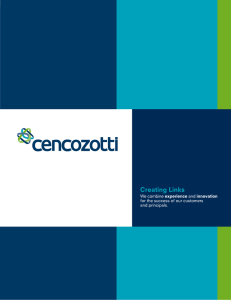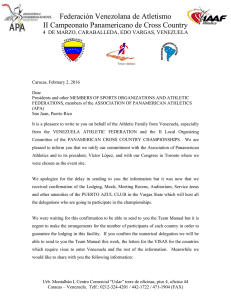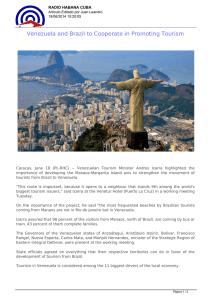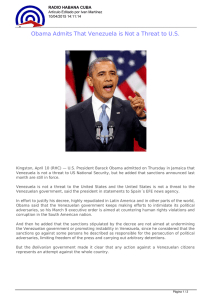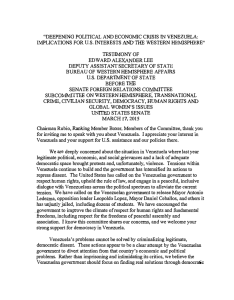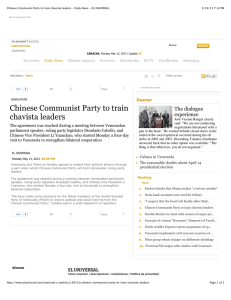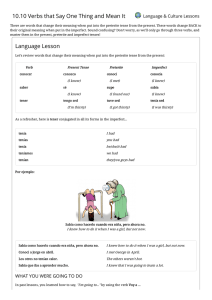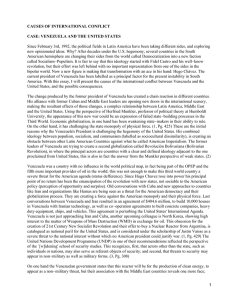Rebel Music: Venezuela is one episode of a six-part
Anuncio
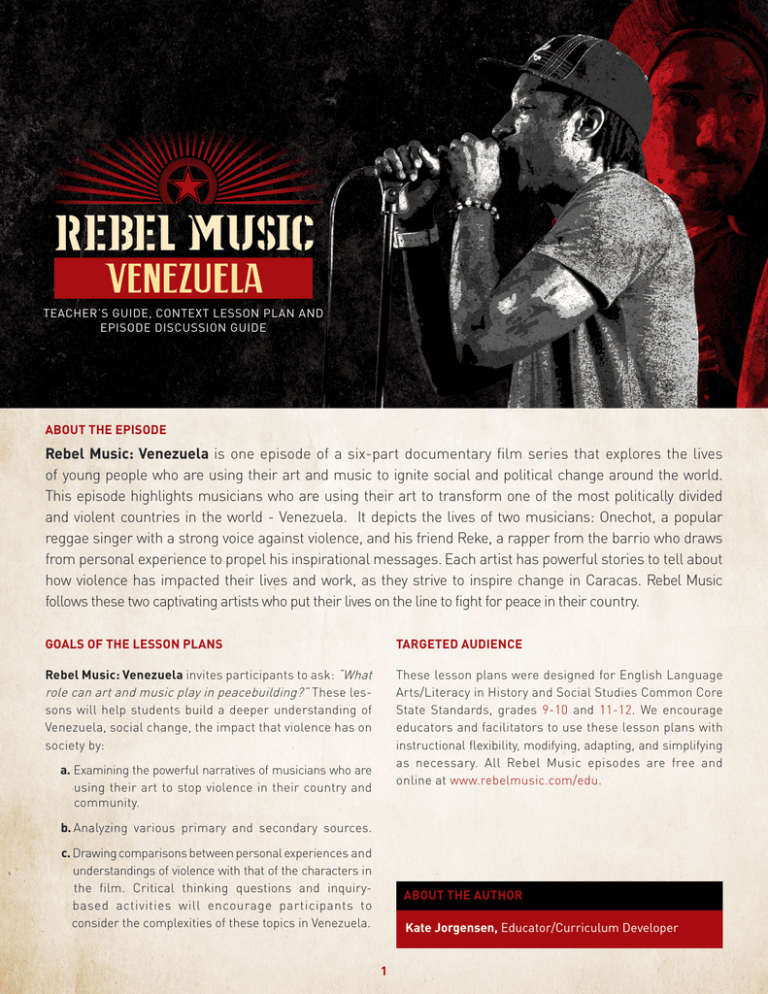
TEACHER’S GUIDE, CONTEXT LESSON PLAN AND EPISODE DISCUSSION GUIDE ABOUT THE EPISODE Rebel Music: Venezuela is one episode of a six-part documentary film series that explores the lives of young people who are using their art and music to ignite social and political change around the world. This episode highlights musicians who are using their art to transform one of the most politically divided and violent countries in the world - Venezuela. It depicts the lives of two musicians: Onechot, a popular reggae singer with a strong voice against violence, and his friend Reke, a rapper from the barrio who draws from personal experience to propel his inspirational messages. Each artist has powerful stories to tell about how violence has impacted their lives and work, as they strive to inspire change in Caracas. Rebel Music follows these two captivating artists who put their lives on the line to fight for peace in their country. GOALS OF THE LESSON PLANS TARGETED AUDIENCE Rebel Music: Venezuela invites participants to ask: “What role can art and music play in peacebuilding?” These lessons will help students build a deeper understanding of Venezuela, social change, the impact that violence has on society by: These lesson plans were designed for English Language Arts/Literacy in History and Social Studies Common Core State Standards, grades 9-10 and 11-12. We encourage educators and facilitators to use these lesson plans with instructional flexibility, modifying, adapting, and simplifying as necessary. All Rebel Music episodes are free and online at www.rebelmusic.com/edu. a. Examining the powerful narratives of musicians who are using their art to stop violence in their country and community. b. Analyzing various primary and secondary sources. c. Drawing comparisons between personal experiences and understandings of violence with that of the characters in the film. Critical thinking questions and inquirybased activities will encourage participants to consider the complexities of these topics in Venezuela. ABOUT THE AUTHOR Kate Jorgensen, Educator/Curriculum Developer 1 TEACHER’S GUIDE, CONTEXT LESSON PLAN AND EPISODE DISCUSSION GUIDE FORMAT OF THE LESSON PLANS: THE CURRICULUM INCLUDES • About Venezuela • Teacher’s Guides • Context Lesson Plans • Episode Discussion Guides (with Extended Learning Opportunities) All lessons are approximately one hour, although some may require follow-up lessons to complete the activities. Context lesson plans should be used before viewing the episode and are meant to prepare students for the topics visited in the episode. These plans contextualize the narratives and topics in Rebel Music by providing an overview of the themes within the episode. The context lesson plans are not intended to give a detailed history of the country. Episode discussion guides include discussion questions, and classroom activities for deeper understanding. The guides are student handouts that ask students to analyze and deconstruct messages and narratives in the episode. Classroom activities help students summarize the central themes of the episode. Extended learning opportunities encourage students to use their knowledge in a way that is personally meaningful, and engages them with their “community.” TIPS FOR IMPLEMENTATION: There are some subtitles in this episode. This may be a distraction or obstacle for some students. Some ideas for watching the episode are: 1. Pause the video 2. Watch the episode twice 3. Preview the questions 4. Split up the questions 5. Have students pick the questions which interest them Breakdancers in the barrio, Caracas. Photo: Rebel Music / MTV World 2 Photo: Rebel Music / MTV World ABOUT VENEZUELA Venezuela is a country on the northern coast of South America, bordering the Atlantic Ocean. Venezuela is surrounded by Guyana to the east, Brazil to the south, and Colombia to the west. Caracas is the largest city in Venezuela and also the capital. With an estimated population of 29 million people, Venezuela’s many people live in cities and urban areas. Almost half of the government’s revenues come from the petroleum sector. Since the discovery of some of the world’s largest oil reserves in 1914 and 1922, 1 oil has become a key subject in Venezuela. Even though the country has large deposits of petroleum, coal, iron ore, bauxite, and gold, the percentage of Venezuelans living in poverty was over 25% as of 2012. 2 Venezuelan statisticians published reports in 2014 showing that one in three Venezuelans are poor. 3 After a three-year democratic period in the ‘40s followed by ten years of military-led government, Venezuela became a democracy in 1958. Decades later, Hugo Chávez was elected president in the 1998 elections and remained in office until he died in 2013. Noted for expanding social programs for the poor, Chávez worked to put his national policy of “21st Century Socialism” in place. 4 Social investment in Venezuela during the Chávez administration did in fact reduce poverty and other issues through social investment. Petroleum revenues funded “missions” to improve health care, sanitation and education, among other things. 5 After Chávez died on March 5, 2013, his successor President Nicolas Maduro continues Chávez’s programs. Map Source: Getty Images President Maduro’s government has faced mass protests and international criticism. 6 Among the current concerns are violent crime and the treatment of protestors. 7,8 As it struggles to overcome issues such as power shortages, food and medicine shortages and inflation, 9 Venezuela is also grappling with one of the world’s highest homicide rates 10 and the average price of oil dropping. 6 1 National Geographic, “Behind The Headlines: Venezuela’s Crisis” http://news.nationalgeographic.com/news/2014/03/140302-venezuela-Chávez-oil-protests-inflation-history-geography/ 1 World Bank Data - Venezuela http://data.worldbank.org/country/venezuela-rb 2 Gobierno Bolivariano de Venezuela, Instituto Nacional de Estadística http://www.ine.gov.ve/index.php?option=com_content&view=category&id=104:pobreza&Itemid=45# 3 The New York Times, “Chávez Restyles Venezuela With ‘21st Century Socialism’” http://www.nytimes.com/2005/10/30/world/americas/Chávez-restyles-venezuela-with-21stcentury-socialism.html 4 CIA, World Fact Book https://www.cia.gov/library/publications/the-world-factbook/fields/ print_2257.html 5 BBC.com, “Venezuela’s Leader Nicolas Maduro Divides Opinion” http://www.bbc.com/news/world-latin-america-20664349 6 BBC.com, “What Lies Behind Protests In Venezuela?” http://www.bbc.com/news/world-latin-america-26335287 7 Reuters, “Venezuela’s Violent Crime Fuels The Death Business” http://www.reuters.com/article/2014/02/20/us-venezuela-crime-idUSBREA1J0KM20140220 8 The L.A. Times, “Shortages, Inflation and Long Lines Have Venezuelans Grumbling” http://www.latimes.com/world/mexico-americas/la-fg-venezuela-economy-shortages-20150123-story.html 9 NBC News, “Venezuela Ranks World’s Second In Homicides: Report” http://www.nbcnews.com/news/latino/venezuela-ranks-worlds-second-homicides-report-n276371 10 Protestors demonstrating in Caracas. Photo: John Moore / Getty Images 2 Photo: AFP / Getty Images CONTEXT LESSON PLAN: VIOLENCE AND ECONOMIC DISPARITIES IN VENEZUELA Overview – In this context lesson plan, students will investigate systematic violence and economic disparities in Venezuela, as well as the impact of violence on the country, by critically reading and viewing primary and secondary sources. KEY TERMS OBJECTIVES - PART 1 • Students will read, analyze, and synthesize primary and secondary sources. • Economic disparity • Students will organize information on protests and consider the impact of violence on Venezuela on different communities. • Food shortages • Inflation • Primary source: a document or physical object which was written or created during the time or topic under study; provide testimony or direct evidence. Examples include speeches, letters, diaries, interviews, government documents, maps, photographs, news film footage, interviews, poetry, drama, novels, music, art, clothing, buildings, furniture COMMON CORE STATE STANDARDS CCSS.ELA-LITERACY.RH.9-10 & 9-10.2 (Grades 9-10). Cite specific textual evidence to support analysis of primary and secondary sources, attending to such features as the date and origin of the information. Determine the central ideas or information of a primary or secondary source; provide an accurate summary of how key events or ideas develop over the course of the text. • Secondary source: interprets, synthesizes, and analyzes primary sources. Examples include textbooks, magazine articles, commentaries, and encyclopedias CCSS.ELA-LITERACY.RH.11-12.1 & 11-12.2 (Grades11-12). Cite specific textual evidence to support analysis of primary and secondary sources, connecting insights gained from specific details to an understanding of the text as a whole. Determine the central ideas or information of a primary or secondary source; provide an accurate summary that makes clear the relationships among the key details and ideas. A man attends a protest against the government of Venezuelan President Nicolas Maduro. Photo: Raul Arboleda / Getty Images 1 CONTEXT LESSON PLAN MATERIALS • Music video - “Rotten Town,” by Onechot http://vimeo.com/14210701 or https://www.youtube.com/watch?v=5YJQuIxijl4 • Music lyrics (text) - “Rotten Town,” by Onechot http://www.musica.com/letras.asp?letra=1538925 • Primary sources on violence in Venezuela ○ “Rotten Town” by Onechot ○ “Violence in the Streets of Venezuela,” ABC News http://abcnews.go.com/WNT/video/violence-streets-venezuela-22643026 ○ “Venezuelans report lowest security levels worldwide,” Gallup Poll & statistical report, http://www.gallup.com/poll/175082/latin-america-scores-lowest-security.aspx ○ “Venezuela’s Climate of Crime” Photographic Gallery (*some graphic images), New York Times, http://observatoriodeviolencia.org.ve/ws/ • Secondary sources on violence in Venezuela ○ “Venezuela: A Call for Peace,” by Nicolas Maduro, OP-ED, New York Times, http://www.nytimes.com/2014/04/02/opinion/venezuela-a-call-for-peace.html?smid=tw-share&_r=0 ○ Crime in Venezuela, Wikipedia, http://en.wikipedia.org/wiki/Crime_in_Venezuela • Primary sources on economic disparities and problems in Venezuela ○ Inflation Rates: Venezuela, Trading Economics, http://www.tradingeconomics.com/venezuela/inflation-cpi ○ The Fight for Food in Venezuela, https://www.youtube.com/watch?v=bd9fcPeE3RU ○ Shortage of Food Supply in Venezuela, Free Thinking News, Interviews https://www.youtube.com/watch?v=AMDVogPZMnU ○ World Bank Poverty Report, http://data.worldbank.org/country/venezuela-rb • Secondary sources on economic disparities and problems in Venezuela ○ “What’s behind Venezuela’s economic woes?” January 2014, BBC News, http://www.bbc.com/news/world-latin-america-25745959 ○ “Venezuela Food Shortages,” The Guardian, http://www.theguardian.com/global-development/poverty-matters/2013/sep/26/venezuela-food-shortages-rich-country-cia ○ “Poverty Shoots Up in Venezuela,” June 2014, Juan Cristobal Nagel http://foreignpolicy.com/2014/06/04/poverty-shoots-up-in-venezuela/ • Graphic organizer for analyzing primary and secondary sources on the protests 2 CONTEXT LESSON PLAN ADDITIONAL RESOURCES • Article on Onechot, “Singer Onechot Becomes Victim of Violence,” Global Voices Online, February 2012, http://globalvoicesonline.org/2012/02/29/venezuela-singer-onechot-becomes-victim-of-violence-he-decried/ • Country Profile and Timeline: Venezuela, Al Jazeera http://www.aljazeera.com/indepth/features/2012/09/20129717592613669.html • Venezuelan Observatory of Violence Website http://observatoriodeviolencia.org.ve/ws/ • Venezuela’s Political Graffiti http://www.aljazeera.com/indepth/inpictures/2012/09/2012930144527686313.html • Venezuela Country Profile, UN Data https://data.un.org/CountryProfile.aspx?crName=Venezuela%20(Bolivarian%20Republic%20of) PROCEDURE 1. READ AND CONSIDER THE TEXT, “ABOUT VENEZUELA”. 2. LAUNCH a. Provide students with Onechot’s “Rotten Town” lyrics. Do a close read of lyrics before viewing the music video. b. Watch “Rotten Town.” Present essential question, “What might be some reasons for violence in Venezuela?” Identify messages related to violence. Interpret symbolism in the video. c. Use “Rotten Town” as the model for how to analyze primary sources using the graphic organizer. 3. INQUIRY Essential questions: “What might be some reasons for violence in Venezuela?” and “How does violence impact Venezuelans?” a. Select primary and secondary sources from the list provided. b. Students can work in small groups to analyze sources by completing the graphic organizer. 4. FOLLOW-UP Do a second viewing of “Rotten Town” and ask students to consider how their inquiry into violence and economic disparities in Venezuela gives them a better understanding of the video. 5. ASSESSMENT Synthesize sources and information from inquiry. a. Is there any relationship between violence and economic disparities in Venezuela? Explain, using evidence from your inquiry. b. Compare and contrast the ways in which information is presented in primary and secondary sources. 3 Photo: Rebel Music / MTV World TEACHER’S EPISODE DISCUSSION GUIDE: VENEZUELA Overview- Rebel Music: Venezuela highlights musicians who are using their art to transform one of the most politically divided and violent countries in the world - Venezuela. It depicts the lives of two musicians: Onechot, a popular reggae singer with a strong voice against violence, and his friend Reke, a rapper from the barrio who draws from personal experience to propel his inspirational messages. Each artist has powerful stories to tell about how violence has impacted their lives and work, as they strive to inspire change in Caracas. Rebel Music follows these two captivating artists who put their lives on the line to fight for peace in their country. OBJECTIVES • Students will consider people’s experiences in Venezuela and how it influences their music. MATERIALS • Access to www.rebelmusic.com • Copies of student handout (Episode Discussion Guide) • Students will analyze quotes from Rebel Music, and texts related to violence and economic disparities in Venezuela. KEY TERMS • Opposition • Peace • Violence • Social class PROCEDURE & EPISODE DISCUSSION GUIDE ASSISTANCE 1. Read and consider the text, “About Venezuela” 6. A bridge. 7. Music helped Reke find an alternate path in life. 2. Preview the questions on the Student Handout Residents are keeping the barrio safe because the police are not. 3. Watch the episode, giving students an opportunity to answer select Discussion Questions. Suggested themes and answers to the Discussion Questions are listed below: 9. Both musicians have experience with violence in life. Onechot, although from a wealthier neighborhood, was shot in the head. Reke, from the barrio, has had many friends murdered and he grew up surrounded by violence. 1. Venezuela is geographically situated as the center for international trading and also has one of the world’s largest oil reserves. Peace is talked about as a metaphor, way of life, innate feeling, something that can be acquired, and something that must be taken seriously. 2. Inequality and necessity drive people to crime, as suggested by Reke. 3. The country is divided because of long and deep historical issues like oil prices, economic decline, concentration of wealth and political power which contribute to social and political tensions. Music is to raise awareness of problems, bring peace to communities, give people a way out of violence, offer people a way to talk about violence and trauma, set aside differences, create deep connections between different people, enact social and political responsibility, and more. 4. He was shot in the head and nearly died. 5. Critics say the “Rotten Town” video is anti-government and violates a law that said you can’t expose “explicit content” on television. 1 CONTEXT LESSON PLAN 4. After watching the episode, give students an opportunity to look at the next section: Questions & Activities for Deeper Understanding. These questions will probe deeper into the central themes of the episode. 1. Asks students to connect with stories in the episode. 2. Asks students to evaluate personal and political responsibility in promoting safety and preventing crime. Many students will have personal connections to this controversial question. 3. Asks students to identify a struggle they’ve had and use it to connect with others. This question will help students connect their personal stories to those in the episode. By asking students to talk about their own experiences, their knowledge of self is strengthened and their stories are validated. 4. Asks students to consider how geography and privilege might craft experiences with the world and influence perspectives on social, political, and historical issues. 5. Is an opinion question about embodying peace and strategies for promoting peace (political strategies, such as protests and music rallies should be considered). Photo: Rebel Music / MTV World 5. Extended Learning Opportunities can be used as follow up activities or assigned for homework. These questions and activities ask students to make connections between the Venezuelan artists, themselves, and their communities. Question 1. Focuses on the purpose of music. Question 2. Employs critical thinking and asks students to use one of the 5 elements of hip-hop to demonstrate their knowledge and ideas of peace. EPISODE DISCUSSION GUIDE - STUDENT HANDOUT DISCUSSION QUESTIONS 1. What makes Venezuela unique? 2. Reke suggests that what factors drive people to crime in Venezuela? 3. Why is the country of Venezuela divided? 4. Describe Onechot’s personal experience with violence. 5. Why has Onechot’s anti-violence music (“Rotten Town”) received criticism from others? 6. Laura Guevara uses what metaphor to describe the power of the music event organized by Onechot? 7. Reke says, “Since I began making music, my entire life changed because music helped me find______________________________.” 8. Who is keeping the community safe in Reke’s neighborhood, and why? 9. What are the similarities and differences between Onechot and Reke’s stories? 10. Explain the differing voices on peace. 11. Describe how musicians’ see the purpose and power of music. QUESTIONS & ACTIVITIES FOR DEEPER UNDERSTANDING 1. What story of violence (or peace) stands out to you the most and why? 2. Do individuals or the government have a greater responsibility in preventing crime? 3. German and Onechot have a special relationship based on their experiences with violence. How can you use a unique experience or trauma you’ve had to connect with or help others? 4. “I try to offer my bros a different perspective on life” (Reke). How are our experiences limited to where we grow up or live? How has music helped broaden your understanding of the world? 5. In your opinion, what is the best way to promote, and embody, peace in a violent neighborhood or country? Does peace exist in everyone’s hearts? EXTENDED LEARNING OPPORTUNITIES 1. Is music “fashion” or “culture”? Select and research two of your favorite artists and gather information for the following questions: a. What messages about social, political, or historical issues do they include in their music? b. How is their ethnicity, language, religion, sexuality, class, gender etc. part of their music? c. Does the musician do TV commercials, movies, or promote specific brands? d. In what ways has the musician influenced youth and how do you know? e. In your opinion, is their music more “fashion” (trendy) or “culture”? And, does it matter? Do musicians have a responsibility to use their music as “culture” instead of “fashion”? 2. Use all the differing perspectives on peace in the episode (include your own ideas), design a piece of graffiti, slam poetry, performing art that reflects and presents these different ideas. 1 (Who, what, when, where) (Who, what, when, where) Specific examples of economic disparities Specific examples of violence GRAPHIC ORGANIZER Primary Source Primary Source Secondary Source Primary Source Primary Source Secondary Source (Why) Possible reason(s) for violence (Why) Possible reason(s) for economic disparities (How) Way(s) in which violence impacts Venezuelans (How) Way(s) in which economic disparities impact Venezuelans
